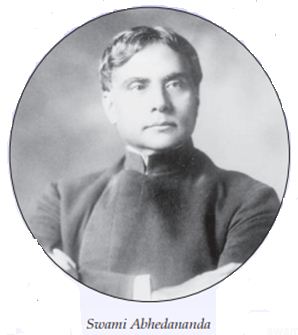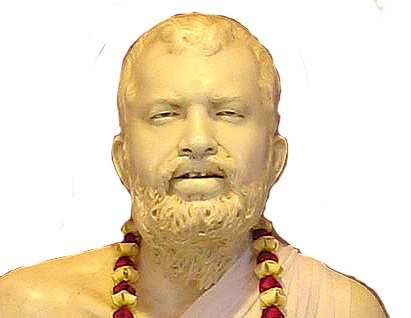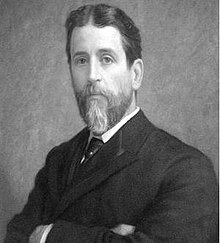The spiritual atmosphere of Dakshineswar, Shyampukur and Cossipore, places sanctified by the austerities of KaliTapasvi, were vibrating in tune with the hymn – ‘Who has entered my temple / the whole sky has become a firmament of immortality / the evil nights have submerged in all quarters / all doors opened up automatically / all lamps have lit themselves / all veenas are rendering new tunes.’1 What a wonderful spiritual ambience it was! As if the doorway of restrained consciousness endeavoured to unfold gently like petals of lotus. All the lamps lit up, the veenas started resounding. The rhythm and the tempo was refreshing. As the young Kali proceeded slowly, charmed by an immaculate tune of spiritual rejuvenation, he came across a new personality. Why is that personality new? For He is ‘the monarch of renunciation’. He cuts asunder the bonds of the Kali Yuga; and yet His humility touches the ground! The Noumenon behind this worldly phenomenon, a single beatific glance of His washes away a thousand sins. He disseminates love among all impartially, renouncing all pride of birth and caste. Who is He? It is very difficult to describe Him. He has neither a beginning nor an end. He is beyond relative measure. Yet we speak of Him. We worship His form. We meditate on Him as our own soul. ‘From whom all the previous incarnations of yore have emanated, as partial manifestations, He Himself has come to Dakshineshwar’2 Lotuses with hundred and thousand petals have effloresced in the heart-lake by His prodigious tenderness and clement breath. Ignorance has been washed away. He has showered His grace on all – on one hand he blessed Girish and Ram, on the other the elite freethinker Narendranath and the rustic illiterate Rakhturam. His grace extended even to the famous dramaturge Binodini. ‘Who can know you, O Lord, if you do not reveal Thyself!’ He revealed himself to Chinu Sankhari, the poor oyster-shell trader. He is the apple of the eyes of the people of Kamarpukur; for He is none other than their Gadai. To the devotees He is the Absolute Godhead! Envisioned in the mirror of conscience of Vivekananda, He is Sri Ramakrishna – the ‘sovereign of all Incarnations’.
Each and every flower that bloomed on Sri Ramakrishna plant is fascinating and gorgeous, fabulous in affability and fragrance, ravishing and resplendent. The mind leaps in joy at their sight. One of these outstandingly marvellous flowers was Kali-Tapasvi, later known as Swami Abhedananda. What was his experience of Sri Ramakrishna? In his own words, ‘Sri Ramakrishna came this time in the disguise of an individual, as an expression of the condensed spiritual fervour of all the earlier avataras, essentially the incarnation of harmony.’3

After Sri Ramakrishna blessed Kaliprasad, he had two wonderful divine visions. He experienced the essence of the mantra ‘Diviva Chakshuratatam’. He got a direct insight into the words of the Gayatri mantra. Another day he had a miraculous vision which he later explained thus, ‘One night during the small hours when I was in meditation, I lost senseconsciousness and it seemed as though my soul came out of the cage of the body and began to roam about in the sky above like a free bird. Gradually it flew high towards infinity. While viewing scenery of great beauty I entered that place… I was charmed to see the different ideals and emblems of Shakta, Shaiva, Vaishnava, Ganapatya, Christianity, Islam, and other sects. Gradually, as if charged with inspiration by some disembodied spirit, I entered into a big hall and saw all the Gods and Goddesses, all Incarnations of God and founders of religion… in the centre of the hall Paramahamsadeva was standing. I was looking at this strange scene when Paramahamsadeva’s form became luminous and assumed immense proportions and all gods and goddesses… started entering into Paramahamsadeva’s body. Having failed to understand the significance of that vision I hastened to Dakshineswar and narrated the whole story to Paramahamsadeva. On having heard me Paramahamsadeva said, “You have had vision of Vaikuntha (the heavenly abode of God). You have reached the last limit of vision of Gods and Goddesses. From now onwards you are uplifted to the stage of the formless.”’4
Kali’s Thakur and Thakur’s Kali – we can find the essence of this feeling in the preceding incident. In many of Swami Abhedananda’s letters his intense devotion towards the Master has been clearly expressed. He writes to Chunilal Bose, a neighbour of Sri Balaram Bose, ‘Do not be anxious; wait and pray. Unless the time is ripe, nothing will click. Call on God day and night. He will eliminate all your afflictions. He is very compassionate. He never can watch anyone’s suffering. Whoever wants whatever from Him, He bestows that to him.’ Each and every word of this statement signifies the eternal message of Sri Ramakrishna. In another letter to Swami Ramakrishnananda he writes, ‘I am sorry to learn about Miss Glenn’s illness. Tell me, why should I be annoyed with her? She is shielded by Thakur… “Mother, it is nobody’s fault.”’ This is the acme of Swami Abhedananda’s love for Sri Ramakrishna. ‘Whoever worships Gauranga, he is dearest to me.’ On 29 June 1937 he wrote to a devotee, ‘You can get peace by surrendering yourself to His will.’ His letters provide a compendious view of The Gospel of Sri Ramakrishna. What is that? That is – ‘surrender, surrender, and surrender.’
He writes in a letter dated 3 July 1934, ‘Have deep faith in your heart that Sri Sri Thakur is your saviour…. He is Kalpataru, the wish-fulfilling tree. Whatever you seek from him with one-pointed devotion, He will give you. He only can give you strength to perform austerities and fortitude, to go ahead in your spiritual life. We are only his instruments.’ Truly, as a devotee says, ‘Who can know You, O Lord, if you do not reveal Thyself!’ यमेवैष वृणुते तेन लभ्यः तस्यैष आत्मा विवृणुते तनूं स्वाम् – ‘He reveals Himself only to those who chooses to know Him.’5 The same emotion has been manifested in every stanza of Swami Abhedananda’s letters. Like father, like son! From the life of father (Sri Ramakrishna), from his uttered sentences, we get the teachings of discrimination and dispassion, study of scriptures, renunciation, service and overall surrender to God for realizing Him. Looking through the prism of Swami Abhedananda’s letters we get the same words – realizing God, company of holy men, solitude, surrender and obviously, faith.
The anxious call of Sri Ramakrishna from the roof of the Kuthi6 is still vibrating in the air. He cried ‘O my children, where are you? Come forth!’ ‘Days are passing. When will you realize God? Days are passing. Everything will go in vain unless God is realized…Thought of that makes me perturbed.’ इह चेदवेदीदथ सत्यमस्ति न चेदिहावेदीन्महती विनष्टिः—‘Having known thus, one stays in the Truth. By not knowing thus one is at a great loss!’7 How intense is his wistfulness, agony and pain for us! How great is his suffering due to our inability to realize God! Few only are able to hear his call. Whatever it be, Sri Ramakrishna is eternal, perennial.
However, तदूरे तद्वन्तिके तदन्तरस्य सर्वस्य तदु सर्वस्यास्य बाह्यतः—It is far and likewise near. It is inside all this and also It is outside all this.8
Whoever wants Sri Ramakrishna with innerlonging, he does not need to search outside. Because Sri Ramakrishna Himself has said, ‘Who has here, he has there also.’ After his passing away, he appeared to Sri Sarada Devi and told her, ‘See I am here itself, I have gone nowhere. It is like this room and that room only.’ There is no doubt that even today, whoever seeks to realize Sri Ramakrishna, will realize His burning presence. Although He is present everywhere, yet at some places his manifestation is prominent. The essence of a cow is prominent in its teats; Ganga water is present all along its bank, but it is prescribed to take bath only in some particular ghats. Similarly, His manifestation is conspicuous at certain places. Once the Master had told Naren, ‘Wherever you will carry me on your shoulders, I will stay there.’ After He passed away Swamiji carried His Atmaram (sacred relics of the Master kept in a copper vessel) on his shoulders and consecrated it grandly on the bank of the Ganga at Belur Math. Thus, this place is extremely holy.
In the end, we shall pray to God with folded hands to unfold our innerconsciousness. For He is the pole-star of our life; the vessel of peace for our thirsty souls. So our final offering to Him is, ‘O Lord! You are mine, I am yours.’
References
1. English translation of Rabindranath Tagore’s song – Gitabitan, Rabindranath Tagore, Vishwabharati, Kolkata, 2005, page 182
2. Sangitartha Sangraha, Probationers’ Training Centre, Belur Math, 2006, page 56
3. English translation of ‘Vishwachetanay Sri Ramakrishna’, Swami Prameyananda & others, Udbodhan Office, Kolkata, 1993, page 66
4. Complete Works of Swami Abhedananda, [hereafter CWSA] Ramakrishna Vedanta Math, Calcutta, 1970, Vol. 10, page 629-630
5. Katha Upanishad, 1.2.23
6. A bungalow in the Dakshineshwar Temple complex
7. Kena Upanishad, 2.5
8. Isa Upanishad, 5
Source : Vedanta Kesari, February, 2017


